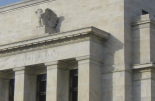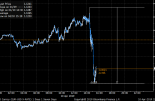BlueBay AM: Inflation is everywhere

By Mark Dowding, CIO, BlueBay Asset Management
It has been another tumultuous week for financial markets. Early in July, markets regained some composure on better activity data out of Europe and the US, but that has proved to be fleeting as yet another high side print on US CPI has opened the door on a 100bps hike from the Federal Reserve (Fed) at the end of July.
Markets have acted accordingly, with equities and credit under pressure and the US dollar continuing to appreciate. Over recent days, the euro has weakened to parity versus the US dollar – a level not seen for nearly 20 years. Volatility in core rates markets remains extreme. Since the middle of June, intraday yield swings of 20bps have become commonplace – levels more commonly associated with emerging markets.
Headline US CPI inflation printed 9.1% (expected 8.8%) in June, with broad-based inflation pressures across energy, food and perhaps more concerningly, core components including shelter, new and second-hand cars, and service sectors.
Given the decline in commodities, in particular retail gas prices, we remain confident that headline inflation pressures will moderate over the coming months, but there is no doubt that this report will make the Fed more uncomfortable.
The important point for markets is it banishes hopes for a moderation from the Fed in the near term and accentuates fears that growth is going to roll over dramatically in the coming months.
As we write, the market is pricing in 85bps from the Fed on 27 July. We nervously stick to our base case that the Fed will “only” hike by 75bps at the end of the month, but our conviction in this has moderated. Yesterday, we saw Fed policy maker Waller lean towards a 75bps hike, and today attention will turn to Bullard to see if we get a further steer ahead of the Fed’s blackout period.
The short-duration stance we initiated at the beginning of July in the 10-year part of the curve has worked well, but we have realised gains on this position in the wake of the CPI report, given concern that further downward pressure on risky assets drives safe-haven flows and further inversion of the yield curve.
Sentiment in Europe has not improved either, with the market holding its breath to see if Putin allows the flow of natural gas through the Nord Stream pipeline to resume at the end of July. The pipeline is currently undergoing annual maintenance that cuts off supply through this channel completely.
The uncertainty for the market is whether Russia allows the flow of gas to continue once the scheduled maintenance is complete. Prior to the shut down on 11 July, Russia was already putting a squeeze on flows (down to 40% of normal capacity), and there is no way of knowing what level of flow will resume after 21 July, when maintenance is scheduled to end.
The range of outcomes is wide – if the pipeline does not re-open, most of Europe could face energy rationing that will probably kick off a severe economic disruption and almost certainly a recession. If it does open back to pre-maintenance levels, there will be relief but still material problems for the European economy. If the flows increase above 50% of normal levels, Germany in particular will be able to rebuild gas stocks and the relief rally could be enormous.
Right now, we don’t believe anyone has visibility as to what Putin will decide to do. Given the challenges facing Europe, we continue to skew duration in the region to the long side and have short positions in the euro (vs. the US dollar), and peripheral European currencies including the Polish zloty and the Czech koruna.
In the periphery, we saw some weakness in Italian spreads yesterday, as they widened back to levels seen in the immediate aftermath of the ECBs ‘announcement of an announcement of an anti-fragmentation tool’. This came as Five Star boycotted a confidence vote on the government, leading Mario Draghi to tender his resignation as Prime Minister last night.
President Mattarella seems to have rejected this, and the next steps are somewhat uncertain, but there are fears that the current coalition could collapse, with potential early elections resulting. It is clear that politics remain a risk in Europe and confirms that while an ECB tool may cap spreads, it won’t fully stop the volatility in a post-QE world.
Turning to the UK, with Johnson now history, attention is focused on who will be the next leader of the Tory Party and prime minister. The front runners are former Chancellor Rishi Sunak and relative unknown Penny Mourdant. The challenges facing whoever wins are huge, and with the new leader only taking charge in mid-September, there is currently a vacuum of power, given that Johnson remains camped out in Dowding Street.
In the meantime, the country faces stagflation risks and policy paralysis. We remain bearish on UK Gilts and the pound. We also continue to run the curve steepener in the UK, long December 2022 money market rates versus short the longer-dated 10-year Gilts. Here, the thinking is the Bank of England will fail to deliver the interest rate hikes that are currently built into the front end of the curve.
With so many headwinds and uncertainties buffeting the investment landscape, it’s difficult to be anything other than cautious and defensive at the current time. Over the medium term, we hold to the view that the second half of the year will be more positive than the first, but right now it is prudent to be cautious. We are in the mode of simplifying the book and playing safe. Keeping powder dry until the outlook begins to clear should pay dividends.










